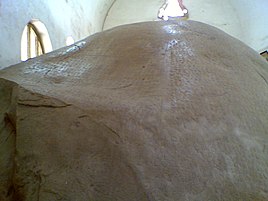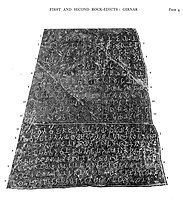Girnar
hideThis article has multiple issues. Please help or discuss these issues on the talk page. (Learn how and when to remove these template messages)
|
| Girnar Mount | |
|---|---|
| ગિરનાર પર્વત Girinagar Revatak Parvata | |
 Mount Girnar from Bhavnath | |
| Highest point | |
| Elevation | 1,069 m (3,507 ft) |
| Listing | List of Indian states and territories by highest point |
| Coordinates | 21°29′41″N 70°30′20″E / 21.49472°N 70.50556°ECoordinates: 21°29′41″N 70°30′20″E / 21.49472°N 70.50556°E |
| Geography | |
| Geology | |
| Mountain type | Igneous |
Girnar is an ancient hill in Junagadh, Gujarat.
Geology[]
Mount Girnar is a major igneous plutonic complex which intruded into the basalts towards the close of the Deccan Trap period. The rock types identified in this complex are gabbros (tholeiitic and alkalic), diorites, lamprophyres, alkali-syenites and rhyolites. The parent gabbroic magma is shown to have given rise in sequence to diorites, lamprophyres and alkali-syenites. The rhyolite, though earlier considered a product of differentiation, is now believed to be an independent magma without any genetic link with the gabbro and its variants.[1][2]
History[]

Ashoka's edicts at Mount Girnar, Junagadh[]
Fourteen of Ashoka's Major Rock Edicts, dating to circa 250 BCE, are inscribed on a large boulder that is housed in a small building located outside the town of Junagadh on Saurashtra peninsula in the state of Gujarat, India. It is located on Girnar Taleti road, at about 2 km (1.2 mi) far from Uperkot Fort easterly, some 2 km before Girnar Taleti. An uneven rock, with a circumference of seven meters and a height of ten meters, bears inscriptions etched with an iron pen in Brahmi script in a language similar to Pali and date back to 250 BCE, thus marking the beginning of written history of Junagadh.[3]
On the same rock there are inscriptions in Sanskrit added around 150 CE by Mahakshatrap Rudradaman I, the Saka (Scythian) ruler of Malwa, a member of the Western Satraps dynasty (see Junagadh rock inscription of Rudradaman).[3] The edict also narrates the story of Sudarshan Lake which was built or renovated by Rudradaman I, and the heavy rain and storm due to which it had broken.[4]
Another inscription dates from about 450 CE and refers to Skandagupta, the last Gupta Empire.[4]
The protective building around the edicts was built in 1900 by Nawab Rasool Khan of Junagadh State at a cost of Rs 8,662. It was repaired and restored in 1939 and 1941 by the rulers of Junagadh. The wall of the structure had collapsed in 2014.[5]
A much smaller replica of these Girnar edicts has been positioned outside the entrance of the National Museum in Delhi.[6]
Similarly, inside the Parliament Museum at New Delhi, an exhibit replicates the act of artists sculpting inscriptions of Girnar edict on a rock.[7]

Ashoka's Rock Edict

Housing for Ashoka's edicts.

Estampage of a part of the inscriptions.







